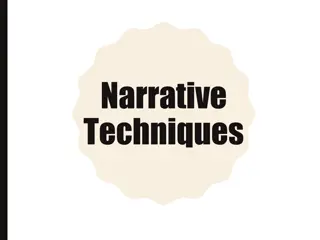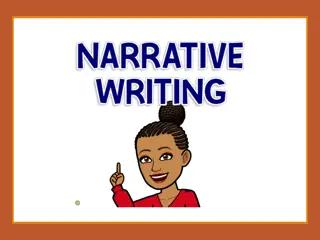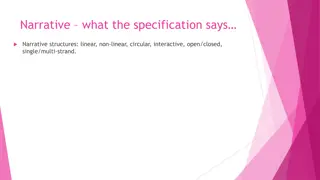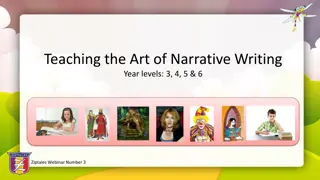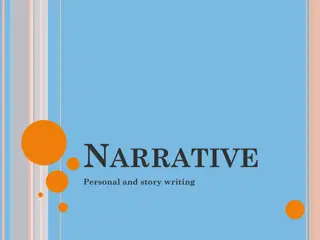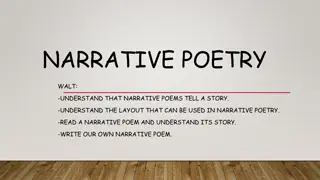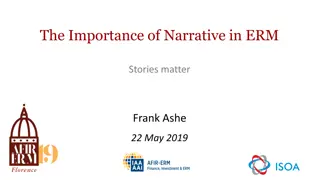Elie Wiesel's Narrative Techniques
Delve into the second chapter of Elie Wiesel's work and analyze the narrative techniques he employs. From vivid imagery to effective characterization, uncover the storytelling elements that bring the text to life. Discover the significance behind Madame Schächter's visions and the detailed portrayal of her son. Reflect on the tone and mood created by Wiesel's writing style, capturing the emotional essence of the story. Gain deeper insights by examining the parallels between characters and unraveling the themes woven into the narrative.
Download Presentation

Please find below an Image/Link to download the presentation.
The content on the website is provided AS IS for your information and personal use only. It may not be sold, licensed, or shared on other websites without obtaining consent from the author.If you encounter any issues during the download, it is possible that the publisher has removed the file from their server.
You are allowed to download the files provided on this website for personal or commercial use, subject to the condition that they are used lawfully. All files are the property of their respective owners.
The content on the website is provided AS IS for your information and personal use only. It may not be sold, licensed, or shared on other websites without obtaining consent from the author.
E N D
Presentation Transcript
LISTEN TO CHAPTER TWO, AND AS YOU DO, MAKE NOTE OF ANY NARRATIVE TECHNIQUES YOU THINK ELIE USES WELL THIS COULD INCLUDE: IMAGERY (OR ANY OTHER FIGURATIVE LANGUAGE) COMPARISON EFFECTIVE CHARACTERIZATION DIALOGUE INTERNAL REFLECTIONS TRY TO LIST AT LEAST 5 TECHNIQUES IN DETAIL
CONSIDER CHAPTER TWO, AND GIVE IT A CHAPTER TITLE OF SIX WORDS OR LESS YOU MAY RECORD YOUR TITLE ON THE COPY OF CHAPTER TWO YOU HAVE MAKE SURE YOU PUT YOUR NAME NEXT TO IT TO CLAIM CREDIT, PLEASE.
WHY IS IT SIGNIFICANT THAT MADAME SCHCHTER KEPT SEEING FLAMES THAT WERE NOT THERE?
WHY DID ELIE INCLUDE SO MANY DETAILS ABOUT MADAME SCH CHTER S SON?
MADAME SCHCHTERS SON 1. HER LITTLE BOY WAS CRYING, HANGING ONTO HER SKIRT, TRYING TO TAKE HOLD OF HER HANDS. IT S ALL RIGHT, MUMMY! THERE S NOTHING THERE SIT DOWN THIS SHOOK ME EVEN MORE THAN HIS MOTHER S SCREAMS HAD 2. WE COULD STAND IT NO LONGER. SOME OF THE YOUNG MEN FORCED HER TO SIT DOWN, TIED HER UP, AND PUT A GAG IN HER MOUTH THE LITTLE BOY SAT DOWN BY HIS MOTHER, CRYING 3. THEY STRUCK HER SEVERAL TIMES ON THE HEAD BLOWS THAT MIGHT HAVE KILLED HER. HER LITTLE BOY CLUNG TO HER; HE DID NOT CRY OUT; HE DID NOT SAY A WORD. HE WAS NOT EVEN WEEPING NOW 4. MRS. SCH CHTER REMAINED HUDDLED IN HER CORNER, MUTE, UNTOUCHED BY THE OPTIMISM AROUND HER. HER LITTLE ONE WAS STROKING HER HAND 5. I THREW A LAST GLANCE TOWARD MADAME SCH CHTER. HER LITTLE BOY WAS HOLDING HER HAND
HOW IS MADAME SCH CHTER SIMILAR TO MOSHE THE BEADLE?
WRITERS REFLECTION TWO: TONE AND MOOD CONSIDER THE SECOND CHAPTER AS A WRITER. AND CONSIDER WHAT NARRATIVE TECHNIQUES DOES ELIE WIESEL USE TO CREATE TONE (HOW THE NARRATOR FEELS ABOUT THE STORY) AND MOOD (HOW THE READER FEELS ABOUT THE STORY)? WHAT TONE AND MOOD DO YOU THINK HE INTENDS TO CREATE HERE? HOW DOES HE DO A GOOD JOB OF ESTABLISHING THESE, OR, HOW COULD HE DO A BETTER JOB AT ESTABLISHING THESE?





